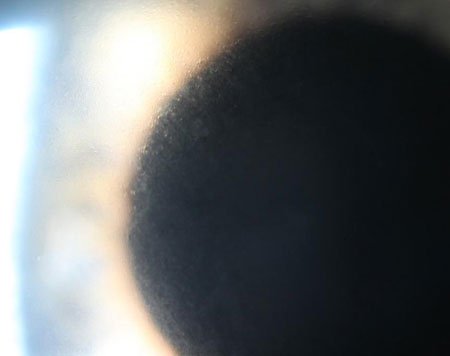BLOG: Some early postop issues just need a tincture of time
If someone were to ask what day of the week was my favorite day, aside from the obvious answer of Friday, I would most likely say postop day. There is an air of optimism from the patients that is unparalleled to any other day of the week.
The fear of the unknown – cataract surgery – has come and gone, and patients will often express their gratitude and appreciation. It can be a very satisfying day for me.
However, a small percentage of patients will have significant concerns the day after surgery, and it’s up to us, as the patient’s comanaging optometrist, to help set their minds at ease and to give them an accurate prognosis. So, let’s take a moment to look at some of the common visual issues seen in the early postoperative period that dampen both the patient’s and the clinician’s enthusiasm.
Postoperative refractive surprise
Many patients will be concerned about their vision the day following cataract surgery. One of their primary fears will be that the wrong IOL was placed and they will need a glasses prescription. Fortunately, other sources of reduced visual acuity – corneal edema, dilation of the pupil, dysphotopsia, etc. – the day after are usually to blame in this very early period. However, even in eyes with a measurable “refractive surprise” the day after, this is far from stable. In many cases, the IOL will “float” anterior as the capsule contracts around it in the first 1 to 2 weeks. This results in a slight myopic shift that is predictable when the IOL appears to be sitting very deep in the posterior chamber.
Other sources of refractive instability occur in patients with unusual corneas, such as post-RK eyes, for example, where refractive stabilization generally takes the entire month postoperatively as the cornea gradually returns to its native state.
Corneal edema
Corneal edema is the most frequent source of reduced vision the day after cataract surgery. The magnitude of corneal edema varies with duration of surgery and the particular surgeon, but is also the final common pathway of a number of insults that develop during and after cataract surgery.Phacoemulsification is traumatic to the endothelium. It creates both thermal and oxidative stress, which can compromise endothelial cells. Therefore, the longer phacoemulsification is required, the greater the corneal edema. This effect is particularly noticeable when dealing with very dense cataracts that require double, triple or even quadruple normal phaco times. Patients with very dense cataracts should, therefore, be counseled about a potentially longer visual recovery compared to run-of-the-mill cataracts.
Likewise, the patient’s own preoperative endothelial function plays a role. If we agree that phaco is traumatic to the endothelium, then it’s no stretch to understand that patients with already-compromised endothelium, say from Fuchs' dystrophy, for example, are more likely to develop corneal edema at any specific phaco time than a patient with normal endothelium.
Further, intraocular spatial relationships play a role. Again, assuming phacoemulsification is traumatic to the endothelium, the closer to the endothelium the phaco tip is, the greater the detrimental effect. Therefore, eyes with shallow anterior chambers have a greater rate of corneal edema, as phaco will always be more proximal to the cornea in these eyes.
The incision construction also impacts edema; while most cataract centers today favor clear corneal incisions (CCIs) over scleral tunnels, CCIs are totally contained to the cornea and create more stress and subsequently more corneal edema.
IOP elevations are the most frequently encountered day 1 problem that requires treatment. The need to treat these eyes is obviously due to the risk of glaucomatous nerve damage, but IOP – which pushes counter to the endothelial pump – is also an independent source of corneal edema. We know this intuitively given the frequent epithelial edema seen in patients with angle closure glaucoma, but the same effect to the cornea is possible regardless of the source of IOP elevation. Patients with very elevated IOP – those over 40 mm Hg, in general, although individual differences manifest, particularly in eyes that have recently gone through the microtrauma of cataract surgery – will often have concomitant epithelial edema that blurs vision to some degree. This edema has a real-time relationship with IOP, and clearing of it will occur simultaneous to reduction in IOP.

Finally, whether the surgeon uses viscoelastic or not will influence the presence of edema. Viscoelastic, which encompass both visco-adhesives and visco-dispersives, are clear jelly-like materials that are injected into the eye to facilitate and make surgery safer. Visco-adhesives create space for the surgeon to work, thereby, reducing the spatial proximity between the endothelium and phaco probe. Visco-dispersives spread out in the anterior chamber and insulate against oxidative endothelial damage. Both forms of visco reduce the presence of postoperative edema, although the flip side of this is that their use is associated with early postoperative IOP spikes and a greater rate of retained lens fragments.
While corneal edema is relatively frequently seen the day after cataract surgery, edema that persists beyond 2 weeks is very uncommon. In most cases, reduction of excess inflammation, reduction of IOP stressors and time will allow the endothelium to, day by day, clear the edema. Although the effectiveness of sodium chloride drops for corneal edema is basically limited to epithelial edema, prescribing this when appropriate can help speed things slightly, as well as empower your patients to accelerate their own recovery. For patients with limbus to limbus edema, risk of permanent decompensation is higher, although a minimum wait of 3 months is required prior to recommending any transplant procedures, and we’ve been surprised, in those rare cases, just how vigorously the endothelium is able to bounce back.

Dysphotopsia
Dysphotopsias – a phenomenon poorly understood in optometry – are suggested to be the primary source of patient dissatisfaction after cataract surgery, which suggests to us that perhaps, as a profession, we ought to familiarize ourselves with it.
Unlike photopsias, which are associated with the pathologic process of retinal traction, migraine aura and choroiditis, dysphotopsias are a fancy way of saying undesirable light reflections that the patient is able to see. The optic of an IOL is significantly smaller than the crystalline lens, leading to light playing off of the edges of the optic. This phenomenon was enhanced with modern acrylic IOLs, which have somewhat different reflective properties than the previous generation of non-foldable PMMA IOLs and was dramatically enhanced with the evolution toward sharp edged optics.
In the late 1990s, traditional round-edge IOL optics were found to be associated with greater rates of posterior capsular opacification. As a result of this research, round-edge design was all but abandoned in favor of sharp-edge optics. As with many things, there was a consequence to this action. Sharp-edge and round-edge optics both disperse the same amount of stray light. Sharp-edge optics, however, concentrate this light on a smaller portion of the retina, leading to more frequent perception of the light, which was ignored as background “noise” with round edges. And, like magic, dysphotopsias were born. Up to 70% of patients see these the day after surgery; in many cases this is due to having a dilated pupil, which will increase perception of the issue. In most cases, with constriction of the pupil early on, supplemented by neuro-adaptation over time, patients will become less and less symptomatic.
For persistent dysphotopsia, there can be a role for short-term miotics, such as brimonidine or pilocarpine, which can help facilitate the neuro-adaptation process. That said, a small population will be so bothered by the issue and do not adapt that an IOL exchange to a different material lens becomes warranted.
These three issues are the most frequent sources of reduced vision the day after cataract surgery and, as you can see, in most cases their severity falls by the wayside over the first 1 to 2 weeks. So, with the aid of the tincture of time, educating your patient on the problem and reassuring them about their prognosis can help them feel more comfortable that what they are experiencing is normal (everybody wants to be normal, especially after cataract surgery!). Of course, you always make it clear that if the patient’s vision is to get worse in the first week, they should contact you immediately.
